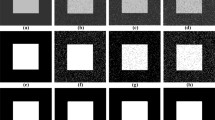Abstract
Finite mixture model (FMM) has been successfully applied to many practical applications in recent years. However, a significant shortcoming of the FMM with Gaussian distribution is that it is sensitive to noise. Recently, Student’s t-distribution with a heavier-tailed acting as a robust alternative to Gaussian distribution is getting more and more attentions. In this paper, we propose a new Student’s t-distribution finite mixture model which incorporates the spatial relationships between the pixels and simultaneously imposes spatial smoothness. In addition, the pixel’s neighbor directional information is also integrated into the proposed model. Furthermore, the pixels’ label probability proportions are explicitly represented as probability vectors to reduce the computational costs of the proposed model. We use the gradient descend method to estimate the unknown parameters of the proposed model. Comprehensive experiments are conducted on both synthetic and natural grayscale images. The experimental results demonstrate the superiority of the proposed model over some existing models.







Similar content being viewed by others
References
Chan T, Vese L (2001) Active contours without edges. IEEE Trans Image Process 10(2):266–277
Li C, Xu C, Gui G, Fox MD (2010) Distance regularized level set evolution and its application to image segmentation. IEEE Trans Image Process 19(12):3243–3254. doi:10.1109/TIP.2010.2096950
Kolmogorov V, Zabin R (2004) What energy functions can be minimized via graph cuts. IEEE Trans Pattern Anal Mach Intell 26(2):147–159
Felzenswalb PF, Zabih R (2011) Dynamic programming and graph algorithms in computer vision. IEEE Trans Pattern Anal Mach Intell 33(4):721–740. doi:10.1109/TPAMI.2010.135
Richard S (2010) Computer vision: algorithms and applications. Springer, New York
McLachlan G, Peel D (2000) Finite mixture models. Wiley, New York
Bishop C (2006) Pattern recognition and machine learning. Springer, New York
Dempster P, Laird NM, Rubin DB (1977) Maximum likelihood from incomplete data via EM algorithm. J R Stat Soc 39:1–38
Geman S, Geman D (1984) Stochastic relaxation, Gibbs distributions,and the Bayesian restoration of images. IEEE Trans Pattern Anal Mach Intell 6:721–741
Besag J (1986) On the statistical analysis of dirty pictures. J R Stat Soc Ser B 48(3):259C302
Celeux G, Forbes F, Peyrard N (2003) EM procedures using mean field-like approximations for Markov model-based image segmentation. Pattern Recogn 36(1):131–144. doi:10.1016/S0031-3203(02)00027-4
Forbes F, Peyrard N (2003) Hidden Markov random field model selection criteria based on mean field-like approximations. IEEE Trans Pattern Anal Mach Intell 25(9):1089C1101. doi:10.1109/TPAMI.2003.1227985
Sanjay GS, Hebert TJ (1998) Bayesian pixel classification using spatially variant finite mixtures and the generalized EM algorithm. IEEE Trans Image Process 7:1014–1028. doi:10.1109/83.701161
Blekas K, Likas A, Galatsanos N, Lagaris I (2005) A spatially constrained mixture model for image segmentation. IEEE Trans Neural Netw 16:494–498. doi:10.1109/TNN.2004.841773
Nikou C, Galatsanos N, Likas A (2007) A class-adaptive spatially variant mixture model for image segmentation. IEEE Trans Image Process 16:1121–1130. doi:10.1109/TIP.2007.891771
Sfikas G, Nikou C, Galatsanos N, Heinrich C (2010) Spatially varying mixtures incorporating line processes for image segmentation. J Math Imaging Vis 36:91–110. doi:10.1007/s10851-009-0174-x
Thanh MN, Wu QM (2012) Gaussian-mixture-model-based spatial neighborhood relationships for pixel labeling problem. IEEE Trans Syst Man Cybern Part B 42:193–202. doi:10.1093/comjnl/bxr032
Peel D, McLachlan GJ (2000) Robust mixture modelling using the t distribution. Stat Comput 10:335–344. doi:10.1023/A:1008981510081
Sfikas G, Nikou C, Galatsanos N (2007) Robust image segmentation with mixtures of student’s t-distribution. In: IEEE international conference on image processing, pp 273–276
Chatzis SP, Kosmopoulos DI, Varvarigou TA (2008) Signal modeling and classification using a robust latent space model based on t distributions. IEEE Trans Signal Process 56:949–963. doi:10.1109/TSP.2007.907912
Chatzis SP, Kosmopoulos DI (2011) A variational Bayesian methodology for hidden Markov models utilizing student’s-t mixtures. Pattern Recogn 44:295–306. doi:10.1016/j.patcog.2010.09.001
Thanh MN, Wu QM (2012) Robust student’s-t mixture model with spatial constraints and its application in medical image segmentation. IEEE Trans Med Imaging 31:103–116. doi:10.1109/TMI.2011.2165342
Xiong T, Yi Z, Zhang L (2012) Grayscale image segmentation by spatially variant mixture model with student’s t-distribution. Multimed Tools Appl. doi:10.1007/s11042-012-1336-1
Zhang Y, Brady M, Smith S (2001) Segmentation of brain MR images through a hidden Markov random field model and the expectation maximization algorithm. IEEE Trans Med Imaging 20:45–57. doi:10.1109/42.906424
Meila M (2003) Comparing clusterings by the variation of information. Lect Notes Comput Sci 2777:173–187. doi:10.1007/978-3-540-45167-9_14
Meila M (2005) Comparing clusterings—axiomatic view. In: International conference on machine learning, pp 577–584
Martin D, Fowlkes C, Tal D, Malik J (2001) A database of human segmented natural images and its application to evaluating segmentation algorithms and measuring ecological statistics. In: Proceedings of IEEE conference on computer vision (ICCV2001), pp 416–423
Freixenet J, Munoz X, Raba D, Marti J, Cufi X (2002) Yet another survey on image segmentation: region and boundary information integration. In: Proceedings of European conference on computer vision (ECCV2002) 408C422
Unnikrishnan R, Pantofaru C, Hebert M (2007) Toward objective evaluation of image segmentation algorithms. IEEE Trans Pattern Anal Mach Intell 29:929–944. doi:10.1109/TPAMI.2007.1046
Svensen M, Bishop C (2005) Robust Bayesian mixture modelling. Neurocomputing 64:235–252. doi:10.1016/j.neucom.-2004.11.018
Titterington DM, Smith AFM, Makov UE (1985) Statistical analysis of finite mixture distributions. Wiley, Hoboken
Thanh MN, Wu QM, Ahuja S (2010) An extension of the standard mixture model for image segmentation. IEEE Trans Neural Netw 21:1326–1338. doi:10.1109/TNN.2010.2054109
Rudin W (1987) Real and complex analysis, 3rd edn. McGraw-Hill, New York
Schwarz G (1978) Estimating the dimension of a model. Ann Stat 4:461–464
Winkler G (2006) Image analysis, random fields and Markov chain Monte Carlo methods, ser. stochastic modeling and applied probability, 2nd edn. Springer, New York
Acknowledgments
The authors would like to thank the anonymous reviewers for their valuable comments and suggestions, which greatly helped to improve the presentation quality of the paper. This work was supported by National Basic Research Program of China (973 Program) under Grant 2011CB302201, and National Nature Science Foundation of China under grant No. 60931160441 and No. 61003042.
Author information
Authors and Affiliations
Corresponding author
Rights and permissions
About this article
Cite this article
Xiong, T., Zhang, L. & Yi, Z. Robust t-distribution mixture modeling via spatially directional information. Neural Comput & Applic 24, 1269–1283 (2014). https://doi.org/10.1007/s00521-013-1358-2
Received:
Accepted:
Published:
Issue Date:
DOI: https://doi.org/10.1007/s00521-013-1358-2




